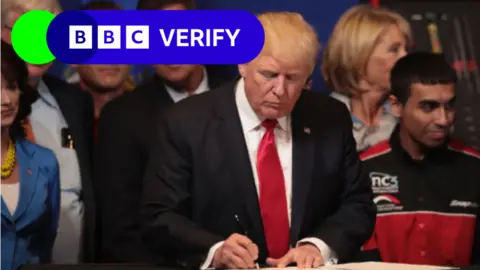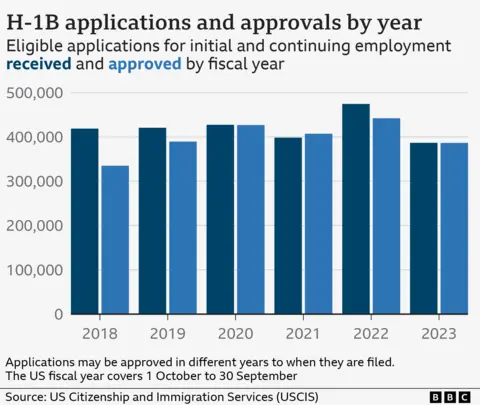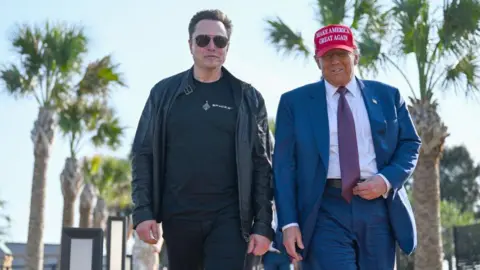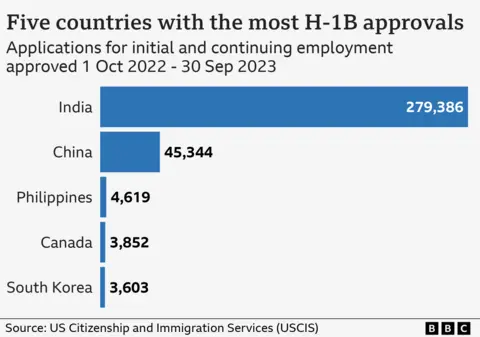What we recognize about US visas Trump supporters are clashing over
 Getty Images
Getty ImagesAn immigration row has erupted between Donald Trump’s supporters over a long-standing US visa programme.
The feud is about H-1B visas, which allow US-based companies to bring in talented workers from abroad into sure industries.
Some immigration hardliners declare the scheme undercuts American workers – but proponents declare the visas allow the US to attract the best expertise from around the globe.
The president-elect has weighed in, saying he supports the programme – despite being critical of it in the history – and tech billionaire Elon Musk has also defended it, saying it attracts the “top ~0.1% of engineering talent”.
Here’s what the data inform us about who gets into the US on these visas.
How many people are approved each year?
The H-1B visas for talented workers were introduced in 1990. They are typically granted for three years, but can be extended for up to six years.
Since 2004, the number of recent H-1B visas issued has been capped at 85,000 per year – 20,000 of which are reserved for foreign students with master’s degrees or higher from US universities.
However, that cap does not apply to some institutions such as universities, ponder tanks and other non-boost research groups, so more are often issued.
People can only apply for an H-1B visa if they have a job lined up with a US-based sponsor corporation or institution.
The US government also approves extensions for those already working in the country.
Just over 386,000 H-1B applications were approved in the 2023 financial year (October 2022-September 2023), the latest year we have packed data for, according to US Citizenship and Immigration Services (USCIS) figures.
That includes almost 119,000 recent H-1B visas and about 267,000 extensions to existing visas.
The 2023 total is down from more than 474,000 in 2022.
There have been efforts to restrict the H-1B programme further in the history.
In 2017, then-president Trump signed an executive order that increased scrutiny of H-1B visa applications. The order sought to enhance fraud detection within the scheme.
Rejection rates hit an all-period high under the first Trump administration, reaching 24% in the 2018 financial year, compared with rejection rates of between 5-8% under the Obama administration and between 2-4% under President Biden.
However, the total number of approved applicants under the Biden administration has been similar to that under Trump’s first.
In the three years that followed President Trump’s executive order (2018-2020), about 1.1 million applications were approved, with about 343,000 of those being recent applicants.
In the first three years of the Biden administration (2021-2023), about 1.2 million applications were approved, with almost 375,000 being recent applicants.

Demand often exceeds the amount of visas granted – in most years there are thousands more applications filed than approved.
In cases in which more applications are received than visas are available, the USCIS effectively runs the H-1B programme as a lottery – which detractors depend highlights a fundamental flaw in the structure.
“Ultimately, if you’re going to have a talented worker programme for ‘talented’ workers, you don’t award these visas via a lottery,” says Eric Ruark, the director of research at NumbersUSA, an organisation that advocates for tighter immigration controls.
“Obviously, that’s not how you discover the best and the brightest.”
We don’t have a packed update on the 2024 numbers yet, but preliminary figures recommend applications have increased sharply.
The number of eligible registrations published by the USCIS showed 758,994 applications in 2024, compared with 474,421 in 2023.
With Trump headed back to the White House in January, Mr Ruark says he believes that the resolution of the H-1B debate will ultimately be among the factors that defines his presidency.
“Is that second term going to be pro-American worker, or revert to the ancient establishment Republican position that immigration is designed to assist employers – at the outlay of American workers?” he says.
“That’s going to be a huge fight in the second term.”
What industries and companies do they work in?
The vast majority of approved applicants work in science, technology, engineering, and mathematics.
Most are in computer-related occupations – 65% in the 2023 financial year.
This was followed by architecture, engineering and surveying – about 10% of people approved in 2023 worked in those sectors.
In terms of companies, Amazon was the top employer of people on H-1B visas in 2024, hiring more than 13,000 staff via the scheme.
Other familiar names like Google, Meta, and Apple characteristic high on the employer list – ranking 4th, 6th and 8th respectively.
Tesla, one of the companies owned by Elon Musk – who has backed the programme – ranked 22nd, employing more than 1,700 people on an H-1B visa.
California and Texas were the states with the most people working on an H-1B visa in 2024.
 Getty Images
Getty ImagesHow much do they earn?
The median yearly profits of people approved to work in the US on an H-1B visa in the 2023 financial year was $118,000 (£94,000).
The median yearly profits for people in computer and mathematical occupations across the US is about $113,000 (£90,000) – slightly less than those in similar sectors via the H-1B programme.
The median household profits in the US is about $60,000 (£48,000) per year.
While opponents of the H-1B structure often make the argument that H-1B holders undercut the salaries of American workers, some immigration lawyers and experts push back on that concept.
The vast majority of H-1B holders earn more than the “prevailing wage” for their occupation – a Department of Labor-determined figure that calculates the average wage paid to similarly employed workers in a particular part of the country.
Shev Dalal-Dheini, elder director of government relations at the American Immigration Lawyers Association, told the BBC that, while prevailing wages “are not a packed labour economy test”, they are indicative of the truth that H-1B visa holders aren’t negatively affecting the rest of the workforce.
“Let’s declare you’re a software engineer in Washington DC. You look at the going rate for software engineers in DC, and you have to certify that you’re paying at least that amount,” says Ms Dalal-Dheini, who also worked on H-1B issues while as an official at USCIS.
“You’re not really undercutting wages that way.”
Additionally, Ms Dalal-Dheini says that US firms must also pay significant fees to file H-1B petitions, often in addition to lawyer fees.
“Companies that complete up sponsoring H-1B [recipients] are looking at costs of up to $5,000 to $10,000 in addition to what you would have to pay an American worker,” she says.
“The net income is that if they could discover an American worker that was qualified, most companies would probably choose to hire that American worker, because it would be a expense funds.”
Where are people coming from?
The vast majority of those approved arrive from India.
The latest data showed around 72% of visas were issued to Indian nationals, followed by 12% to Chinese citizens.
About 1% came from the Philippines, Canada and South Korea respectively.

About 70% of those who enter the US on H-1B visas are men, with the average age of those approved being around 33.
Additional reporting by Becky Dale.




